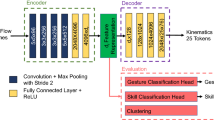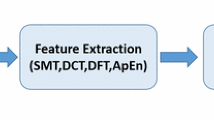Abstract
Purpose
The use of motion sensors is emerging as a means for measuring surgical performance. Motion sensors are typically used for calculating performance metrics and assessing skill. The aim of this study was to identify surgical gestures and tools used during an open surgery suturing simulation based on motion sensor data.
Methods
Twenty-five participants performed a suturing task on a variable tissue simulator. Electromagnetic motion sensors were used to measure their performance. The current study compares GRU and LSTM networks, which are known to perform well on other kinematic datasets, as well as MS-TCN++, which was developed for video data and was adapted in this work for motion sensors data. Finally, we extended all architectures for multi-tasking.
Results
In the gesture recognition task the MS-TCN++ has the highest performance with accuracy of \(82.4 \pm 6.97\) and F1-Macro of \(78.92 \pm 8.5\), edit distance of \(86.30 \pm 8.42\) and F1@10 of \(89.30 \pm 7.01\) In the tool usage recognition task for the right hand, MS-TCN++ performs the best in most metrics with an accuracy score of \(94.69 \pm 3.57\), F1-Macro of \(86.06 \pm 7.06\), F1@10 of \(84.34 \pm 10.90\), and F1@25 of \(80.58 \pm 12.03\). The multi-task GRU performs best in all metrics in the left-hand case, with an accuracy of \(95.04 \pm 4.18\), edit distance of \(85.01 \pm 16.94\), F1-Macro of \(89.81 \pm 11.65\), F1@10 of \(89.17 \pm 13.28\), and F1@25 of \(88.64 \pm 13.6\).
Conclusion
In this study, using motion sensor data, we automatically identified the surgical gestures and the tools used during an open surgery suturing simulation. Our methods may be used for computing more detailed performance metrics and assisting in automatic workflow analysis. MS-TCN++ performed better in gesture recognition as well as right-hand tool recognition, while the multi-task GRU provided better results in the left-hand case. It should be noted that our multi-task GRU network is significantly smaller and has achieved competitive results in the rest of the tasks as well.













Similar content being viewed by others
References
Vozenilek J, Huff JS, Reznek M, Gordon JA (2004) See one, do one, teach one: advanced technology in medical education. Acad Emerg Med 11(11):1149–1154
Ziv A, Wolpe PR, Small SD, Glick S (2003) Simulation-based medical education: an ethical imperative. Acad Med 78(8):783–788
Aggarwal R, Mytton OT, Derbrew M, Hananel D, Heydenburg M, Issenberg B, MacAulay C, Mancini ME, Morimoto T, Soper N, Ziv A, Reznick R (2010) Training and simulation for patient safety. BMJ Qual Saf 19(Suppl 2):34–43
Reznick RK, MacRae H (2006) Teaching surgical skills-changes in the wind. N Engl J Med 355(25):2664–2669
Fonseca AL, Evans LV, Gusberg RJ (2013) Open surgical simulation in residency training: a review of its status and a case for its incorporation. J Surg Educ 70(1):129–137
Epstein RM (2007) Assessment in medical education. N Engl J Med 356(4):387–396
Moorthy K, Munz Y, Sarker SK, Darzi A (2003) Objective assessment of technical skills in surgery. Bmj 327(7422):1032–1037
Martin J, Regehr G, Reznick R, Macrae H, Murnaghan J, Hutchison C, Brown M (1997) Objective structured assessment of technical skill (OSATS) for surgical residents. Br J Surg 84(2):273–278
D’Angelo A-LD, Rutherford DN, Ray RD, Laufer S, Mason A, Pugh CM (2016) Working volume: validity evidence for a motion-based metric of surgical efficiency. Am J Surg 211(2):445–450
Howells NR, Brinsden MD, Gill RS, Carr AJ, Rees JL (2008) Motion analysis: a validated method for showing skill levels in arthroscopy. Arthrosc J Arthrosc Relat Surg 24(3):335–342
Yamaguchi S, Yoshida D, Kenmotsu H, Yasunaga T, Konishi K, Ieiri S, Nakashima H, Tanoue K, Hashizume M (2011) Objective assessment of laparoscopic suturing skills using a motion-tracking system. Surg Endosc 25(3):771–775
Kowalewski K-F, Hendrie JD, Schmidt MW, Garrow CR, Bruckner T, Proctor T, Paul S, Adigüzel D, Bodenstedt S, Erben A, Kenngott H, Erben Y, Speidel S, Müller-Stich BP, Nickel F (2017) Development and validation of a sensor-and expert model-based training system for laparoscopic surgery: the iSurgeon. Surg Endosc 31(5):2155–2165
D’Angelo A-LD, Rutherford DN, Ray RD, Laufer S, Kwan C, Cohen ER, Mason A, Pugh CM (2015) Idle time: an underdeveloped performance metric for assessing surgical skill. Am J Surg 209(4):645–651
Buescher JF, Mehdorn A-S, Neumann P-A, Becker F, Eichelmann A-K, Pankratius U, Bahde R, Foell D, Senninger N, Rijcken E (2018) Effect of continuous motion parameter feedback on laparoscopic simulation training: a prospective randomized controlled trial on skill acquisition and retention. J Surg Educ 75(2):516–526
Jantscher, W.H., Pandey, S., Agarwal, P., Richardson, S.H., Lin, B.R., Byrne, M.D., O’Malley, M.K.: Toward improved surgical training: Delivering smoothness feedback using haptic cues. In: 2018 IEEE Haptics Symposium (HAPTICS), pp. 241–246 (2018). IEEE
Gao, Y., Vedula, S.S., Reiley, C.E., Ahmidi, N., Varadarajan, B., Lin, H.C., Tao, L., Zappella, L., Béjar, B., Yuh, D.D., Chen, C.C.G., Vida, R., Khudanpur, S., Hager, G.G.: Jhu-isi gesture and skill assessment working set (jigsaws): A surgical activity dataset for human motion modeling. In: MICCAI Workshop: M2cai, vol. 3, p. 3 (2014)
Fawaz HI, Forestier G, Weber J, Idoumghar L, Muller P-A (2019) Accurate and interpretable evaluation of surgical skills from kinematic data using fully convolutional neural networks. Int J Comput Assist Radiol Surg 14(9):1611–1617
DiPietro, R., Lea, C., Malpani, A., Ahmidi, N., Vedula, S.S., Lee, G.I., Lee, M.R., Hager, G.D.: Recognizing surgical activities with recurrent neural networks. In: International Conference on Medical Image Computing and Computer-assisted Intervention, pp. 551–558 (2016). Springer
van Amsterdam, B., Clarkson, M.J., Stoyanov, D.: Multi-task recurrent neural network for surgical gesture recognition and progress prediction. In: 2020 IEEE International Conference on Robotics and Automation (ICRA), pp. 1380–1386 (2020). IEEE
Lea, C., Vidal, R., Reiter, A., Hager, G.D.: Temporal convolutional networks: a unified approach to action segmentation. In: European Conference on Computer Vision, pp. 47–54 (2016). Springer
Funke, I., Bodenstedt, S., Oehme, F., von Bechtolsheim, F., Weitz, J., Speidel, S.: Using 3d convolutional neural networks to learn spatiotemporal features for automatic surgical gesture recognition in video. In: International Conference on Medical Image Computing and Computer-Assisted Intervention, pp. 467–475 (2019). Springer
Liu, D., Jiang, T.: Deep reinforcement learning for surgical gesture segmentation and classification. In: International Conference on Medical Image Computing and Computer-assisted Intervention, pp. 247–255 (2018). Springer
Li, S.-J., AbuFarha, Y., Liu, Y., Cheng, M.-M., Gall, J.: Ms-tcn++: multi-stage temporal convolutional network for action segmentation. IEEE Transactions on Pattern Analysis and Machine Intelligence (2020)
Richard, A., Kuehne, H., Gall, J.: Weakly supervised action learning with rnn based fine-to-coarse modeling. In: Proceedings of the IEEE Conference on Computer Vision and Pattern Recognition, pp. 754–763 (2017)
Hochreiter S, Schmidhuber J (1997) Long short-term memory. Neural Comput 9(8):1735–1780
DiPietro R, Ahmidi N, Malpani A, Waldram M, Lee GI, Lee MR, Vedula SS, Hager GD (2019) Segmenting and classifying activities in robot-assisted surgery with recurrent neural networks. Int J Comput Assist Radiol Surg 14(11):2005–2020
Cho, K., Van Merriënboer, B., Bahdanau, D., Bengio, Y.: On the properties of neural machine translation: encoder–decoder approaches. arXiv preprint arXiv:1409.1259 (2014)
Goldbraikh A, D’Angelo A-L, Pugh CM, Laufer S (2022) Video-based fully automatic assessment of open surgery suturing skills. Int J Comput Assist Radiol Surg 17:1–12
McClellan JH, Parks TW (2005) A personal history of the Parks–McClellan algorithm. IEEE Signal Process Mag 22(2):82–86
Carreira, J., Zisserman, A.: Quo vadis, action recognition? a new model and the kinetics dataset. In: Proceedings of the IEEE Conference on Computer Vision and Pattern Recognition, pp. 6299–6308 (2017)
Kuehne, H., Arslan, A., Serre, T.: The language of actions: recovering the syntax and semantics of goal-directed human activities. In: Proceedings of the IEEE Conference on Computer Vision and Pattern Recognition, pp. 780–787 (2014)
Huang C, Huang X, Fang Y, Xu J, Qu Y, Zhai P, Fan L, Yin H, Xu Y, Li J (2020) Sample imbalance disease classification model based on association rule feature selection. Pattern Recognit Lett 133:280–286
Lea, C., Vidal, R., Hager, G.D.: Learning convolutional action primitives for fine-grained action recognition. In: 2016 IEEE International Conference on Robotics and Automation (ICRA), pp. 1642–1649 (2016). IEEE
Lea, C., Flynn, M.D., Vidal, R., Reiter, A., Hager, G.D.: Temporal convolutional networks for action segmentation and detection. In: Proceedings of the IEEE Conference on Computer Vision and Pattern Recognition, pp. 156–165 (2017)
Akiba, T., Sano, S., Yanase, T., Ohta, T., Koyama, M.: Optuna: a next-generation hyperparameter optimization framework. In: Proceedings of the 25rd ACM SIGKDD International Conference on Knowledge Discovery and Data Mining (2019)
Hutter, F., Hoos, H., Leyton-Brown, K.: An efficient approach for assessing hyperparameter importance. In: International Conference on Machine Learning, pp. 754–762 (2014). PMLR
Goldbraikh, A., Shubi, O., Shamir, N., Carla, Laufer, S.: Efficient assessment of surgical maneuvers: Human versus machine. In: 2022 Surgeons and Engineers: A Dialogue on Surgical Simulation (2022). ACS
Twinanda AP, Shehata S, Mutter D, Marescaux J, De Mathelin M, Padoy N (2016) Endonet: a deep architecture for recognition tasks on laparoscopic videos. IEEE Trans Med Imaging 36(1):86–97
Jin, A., Yeung, S., Jopling, J., Krause, J., Azagury, D., Milstein, A., Fei-Fei, L.: Tool detection and operative skill assessment in surgical videos using region-based convolutional neural networks. In: 2018 IEEE Winter Conference on Applications of Computer Vision (WACV), pp. 691–699 (2018). IEEE
Sarikaya D, Corso JJ, Guru KA (2017) Detection and localization of robotic tools in robot-assisted surgery videos using deep neural networks for region proposal and detection. IEEE Trans Med Imaging 36(7):1542–1549
Author information
Authors and Affiliations
Corresponding author
Ethics declarations
Conflict of interest
The authors declare that they have no conflict of interest.
Ethical approval
All procedures performed in studies involving human participants were in accordance with the ethical standards of the institutional and/or national research committee and with the 1964 Helsinki Declaration and its later amendments or comparable ethical standards.
Informed consent
Informed consent was obtained from all individual participants included in the study. *Figures 4 and 5 were created with BioRender.com.
Additional information
Publisher's Note
Springer Nature remains neutral with regard to jurisdictional claims in published maps and institutional affiliations.
Rights and permissions
About this article
Cite this article
Goldbraikh, A., Volk, T., Pugh, C.M. et al. Using open surgery simulation kinematic data for tool and gesture recognition. Int J CARS 17, 965–979 (2022). https://doi.org/10.1007/s11548-022-02615-1
Received:
Accepted:
Published:
Issue Date:
DOI: https://doi.org/10.1007/s11548-022-02615-1





